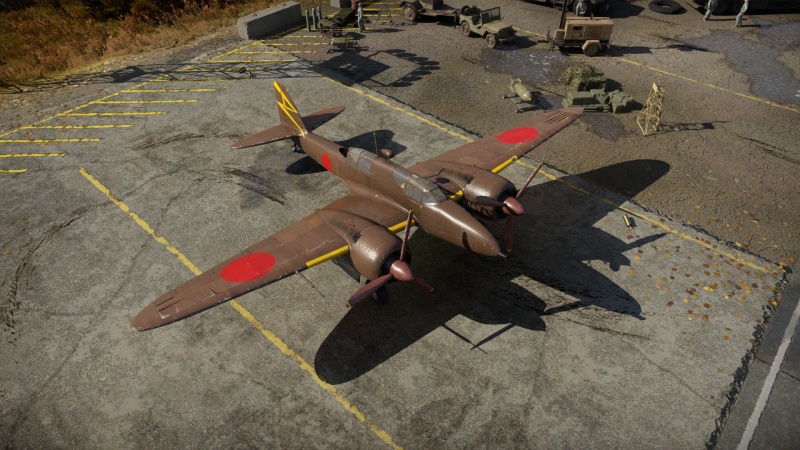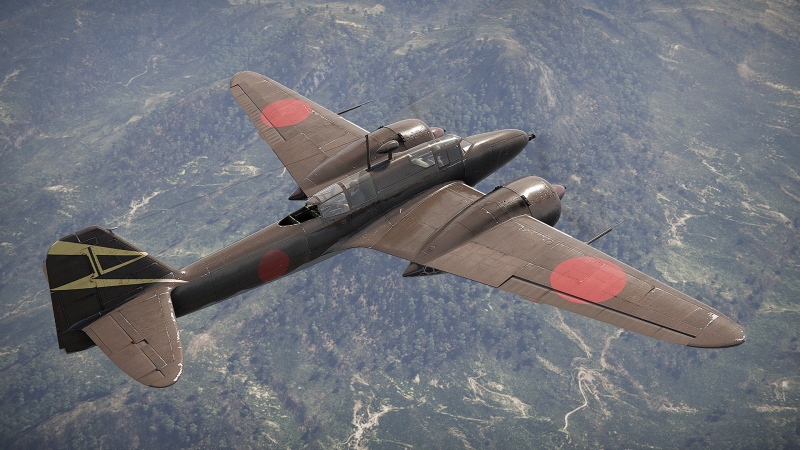Ki-102 otsu
Contents
Description
The Ki-102 otsu, designated (by personnel) as Type 4 Assault Aircraft (四式襲撃機) was a Japanese twin-engine, two-seat, ground-attack aircraft that entered service in 1944. It was the main variant of the Ki-102, which was itself derived from the Ki-45. The Ki-102 otsu had a 57 mm cannon in the nose, two 20 mm cannons in the belly, and a 12.7 mm machine gun in the rear. It was designed to attack enemy ground targets with its powerful armament. The Ki-102 otsu saw limited action in the Okinawa campaign but was mostly kept in reserve to defend Japan from the expected Allied invasion.
It was introduced in Update 1.35. The Ki-102 otsu can be used in two ways: as its intended ground attacker role or as an ad-hoc bomber hunter. For ground attack, the Ki-102 otsu can destroy light and unarmoured targets with its 57 mm cannon, then return to base or use its 20 mm guns for more targets or self-defense. It also has a 12.7 mm rear gun to fend off enemy fighters. For bomber hunting, the Ki-102 otsu can fire its 57 mm cannon from a distance or get close and unleash its 20 mm guns on large and heavy bombers. The 57 mm cannon is powerful but inaccurate, so it is better to fire single shots than bursts. The Ki-102 otsu should avoid the gunner fire of the bombers and attack from a safe angle.
- Nicknames
- Allied reporting name: Randy.
General info
Flight performance
The Ki-102 otsu has a decent speed advantage over most enemy planes in a straight line or dive and very good climb rate. The climb rate is typically better than almost every aircraft it will come up against. As with most Japanese heavy fighters, it is a very fast aircraft. The aircraft is as manoeuvrable as you would expect from a heavy fighter, though quite sluggish in a turn compared to a single engine aircraft. The Ki-102 otsu has good acceleration in a dive due to its two powerful engines and increased weight and decent acceleration when travelling in a straight line.
| Characteristics | Max Speed (km/h at 1,900 m) |
Max altitude (metres) |
Turn time (seconds) |
Rate of climb (metres/second) |
Take-off run (metres) | |||
|---|---|---|---|---|---|---|---|---|
| AB | RB | AB | RB | AB | RB | |||
| Stock | 555 | 537 | 25.5 | 26.1 | 15.4 | 15.4 | 450 | |
| Upgraded | 608 | 580 | 23.6 | 24.5 | 24.9 | 19.5 | ||
Details
| Features | ||||
|---|---|---|---|---|
| Combat flaps | Take-off flaps | Landing flaps | Air brakes | Arrestor gear |
| ✓ | ✓ | ✓ | X | X |
| Limits | ||||||
|---|---|---|---|---|---|---|
| Wings (km/h) | Gear (km/h) | Flaps (km/h) | Max Static G | |||
| Combat | Take-off | Landing | + | - | ||
| 762 | 437 | 408 | 260 | ~9 | ~7 | |
| Optimal velocities (km/h) | |||
|---|---|---|---|
| Ailerons | Rudder | Elevators | Radiator |
| < 360 | < 400 | < 400 | > 312 |
Survivability and armour
The Ki-102b is decently survivable as a twin-engine heavy fighter, but still isn't protected from too much sustained fire; manoeuvre the plane out of gun-fire and get the enemy off your tail using the 12.7 mm in the back which, when loaded with HE, can make short work of your chaser.
The Ki-102 also comes with self-sealing fuel tanks providing additional survivability if the fuel tanks were to get hit, by extinguishing fires and preventing them from running empty, allowing you to make it safely back to the airfield.
- 8 mm steel behind 57 mm cannon
- 8 mm steel on both sides of pilot
- 8 mm steel behind pilot's head
- 8 mm steel on both sides of gunner
- 12 mm steel around 57 mm gun barrel
- 12 mm steel behind pilot
- 12 mm steel in front of fuselage-mounted fuel tank
- 12 mm steel behind fuselage-mounted fuel tank
- 12 mm steel in front of gunner*
- Self-sealing fuel tanks (1 in central fuselage, 3 in each wing)
*Note that the gunner is rear-facing
Modifications and economy
- First, as with most planes, getting ammo belts should provide more control and better firepower over the guns
- Second important matter to upgrading the Ki-102 should be a focus on flight performance, allowing you to hunt bombers or light vehicle columns sooner
- Afterwards, increasing gun accuracy a great plus
Armaments
Offensive armament
The Ki-102 otsu is armed with:
- 1 x 57 mm Ho-401 cannon, nose-mounted (16 rpg)
- 2 x 20 mm Ho-5 cannons, chin-mounted (200 rpg = 400 total)
As a ground attacker, the Ki-102 otsu comes equipped with a 57 mm drum-loaded cannon to engage ground targets with but lacks shell choice and comes only with HE. The gun itself was based on the Ho-203 (37 mm) but increased in size. It lacks velocity and requires the pilot to be rather close to the target to hit anything at all which will make this plane very vulnerable when an attack is initiated.
Along with the Ho-401, it also comes with 2 x 20 mm Ho-5s which provide some good firepower for aerial targets and lightly armoured vehicles at a range unlike the Ho-401.
It is greatly advised to fire the guns separated.
Defensive armament
The Ki-102 otsu is defended by:
- 1 x 12.7 mm Ho-104 machine gun, dorsal turret (500 rpg)
The Ki-102 otsu has a 12.7 mm Ho-104 in the back, which shouldn't be underestimated as it can leave the pursuer burning down to the ground, but the belts for it aren't very favourable as most of them are filled with AP. Universal offers the best single bullet but is only fired every 4 rounds and Default offers a better universality.
Usage in battles
There's 2 gameplay loops that the Ki-102b can provide: either play it in its specific role as a ground attacker or use it as a heavy-duty bomber hunter that will make short work of large planes with few to only a single hit.
- Ground Attack
As the Ki-102b was specifically built for this role, in air battles it can be used to get rid of light and unarmoured targets, from light vehicles to artillery emplacements, usually only requiring a single 57 mm shell to destroy them. You should get as many ground targets in a single pass until the 57 mm is out of ammo and head back to base to re-arm, leaving the 20 mms either for emergency (dog)fighting, or, if the skies are clear enough, continue the ground pound. If the skies are contested and enemies are on your tail, you can make short work of them with the 12.7 mm mounted in the back, especially when loaded with HE ammunition paired with small evasive manoeuvres.
In ground battles, the Ki-102b doesn't provide amazing ground attack capability due to a lack of AP/HEAT for the 57 mm and no suspended armament such as bombs or rockets. It can however overpressure open-top vehicles when hitting crew compartments and make short work of anti-air trucks. If the 20 mms are loaded with AP, these can even be used to hit light-armoured vehicles but will be rather hard to pull off with the size and slow manoeuvrability of the Ki-102.
- Bomber Hunting
While the Ki-102b isn't exactly made for this role, it can decently pull it off with the deadly HE the 57 mm delivers and the damage output the 20mms offer against large and heavy bombers (which other Ki-102 variants would have been tasked with).
While the 57 mm has a rather decent fire-rate for a large calibre aerial cannon, it doesn't hold up in accuracy and it's ill-advised to fire more than 2-3 shells in succession. Attempt to single fire the cannon and snipe bigger planes out of the sky, if this fails or isn't opportune, close in on the target at a safe angle and once close enough pull the trigger to send a full burst with the hopes of landing at least a hit or two and pull out of its gunner fire.
Manual Engine Control
| MEC elements | ||||||
|---|---|---|---|---|---|---|
| Mixer | Pitch | Radiator | Supercharger | Turbocharger | ||
| Oil | Water | Type | ||||
| Not controllable | Controllable Auto control available |
Controllable Not auto controlled |
Controllable Not auto controlled |
Separate | Controllable 2 gears |
Not controllable |
Pros and cons
Pros:
- Powerful 57 mm cannon with surprisingly fast fire-rate
- Decent combined firepower at its BR
- Self-sealing fuel tanks and decent survivability, unlike many Japanese aircraft
Cons:
- 57 mm has poor accuracy/dispersion after 2 shots in full-auto
- Lacks suspended armament and 57 mm AP/HEAT
- Rather slow for its BR
History
By 1943, the Japanese Army decided the Ki-102 was to be developed as a further advancement on the Ki-96, which in turn was a high-altitude prototype advancement of the Ki-45 (Family). The initial 2 planned roles for the Ki-102 were to be the Ki-102a (Ko) as a high-altitude heavy fighter and the latter as a ground-attack variant under the designation Ki-102b (Otsu).
By January 1944, Kawasaki finished the design of the Ki-102b, with the first plane being completed later in March. The Ki-102a started development just after the Ki-102b in January, with the Ko's design being finalized in April of that same year. The first 3 prototype planes were originally all supposed to be Otsu models, but to hasten the development of the Ko model, were reviewed as such.
The Ki-102b was approved for mass production, designated (by personnel) as the Type 4 assault aircraft and was equipped with a Ho-401 (57 mm) in the nose and 2 x Ho-5 (20 mm), on top of the possibility to carry up to 500 kg of bomb load. Reports from deployed planes to units pointed out how the plane would be unstable during take-off, which was temporarily dealt with by extending the tailwheel post, with further plans to extend the fuselage but never materialized until the end of the war.
At the request of high command, the deployed Ki-102s was only supposed to be used for the defense of the mainland in case of an Allied invasion. But very few would see service against bombing raids as additional firepower, others were painted jet-black and utilized as night fighters. By the end of the war, 215 Otsu-types had been produced, excluding prototypes and additional prototypes, including those modified into Ki-102a (Ko) and Ki-108.
Media
- Skins
See also
- Related Development
External links
| Kawasaki Aircraft Industries (川崎航空機工業株式会社) | |
|---|---|
| Biplane Fighters | Ki-10-I · Ki-10-I C · Ki-10-II · Ki-10-II C |
| Fighters | Ki-61-I ko · Ki-61-I otsu · Ki-61-I hei · Tada's Ki-61-I hei · Ki-61-I tei · Ki-61-II Otsu Kai |
| Ki-100 · Ki-100-II | |
| Interceptors | Ki-45 ko · Ki-45 otsu · Ki-45 hei · Ki-45 tei |
| Ki-96 | |
| Ki-102 otsu | |
| Ki-108 Kai | |
| Bombers | Ki-32 |
| Ki-48-II otsu | |
| Captured | ␗Ki-45 hei/tei · ␗Ki-61-I otsu · ▃Ki-61-Ib |
| See also | Kawasaki Shipyard Co. |
| Japan twin-engine fighters and strike aircraft | |
|---|---|
| Navy | |
| Land-based Fighter | |
| J1N | J1N1 |
| J5N | J5N1 |
| Army | |
| Ki-45 | Ki-45 ko · Ki-45 otsu · Ki-45 hei · Ki-45 tei |
| Ki-83 | Ki-83 |
| Ki-96 | Ki-96 |
| Ki-102 | Ki-102 otsu |
| Ki-108 | Ki-108 Kai |
| Ki-109 | Ki-109 |






